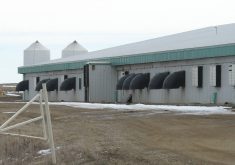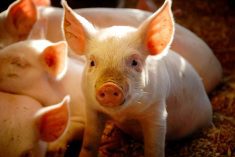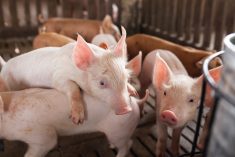Glacier FarmMedia – When a multiplication pig barn came down with a Streptococcus zooepidemicus outbreak in March 2019, Maple Leaf Foods staff scrambled to figure out what it was and how to treat it.
At first, they dealt with it as suggested by worldwide veterinary authorities. Believing the gilts were over the illness, they were sent into four sow barns. Within a month, the company had 10,500 infected sows on its hands.
Every day, dozens of mature sows died. Gilts were aborting litters. Staff were becoming exhausted from caring for sick pigs.
Read Also

Beekeepers want financial protection against tropi mite
Tropilaelaps (tropi) mites haven’t landed in Canada yet; beekeepers want to know they’ll get federal financial help if the deadly bee parasite ever does
It was a nightmare.
Why it matters: Even narrow biosecurity gaps can become big problems in the hog barn.
This went on for four years, causing millions of dollars in damage, thousands of pig deaths and pushing employees to the brink. One barn was taken out of production, and Maple Leaf almost despaired of safely repopulating it after having to depopulate it three times from 2020 to 2023.
Since the pigs themselves didn’t seem to be the underlying root of infection, the investigation turned to other organisms.
“We were collecting bees. We were collecting flies. We were collecting mice, anything that could potentially carry the disease,” said Maple Leaf animal health manager LeeAnn Peters.
Bacterial culture tests were also conducted with workers. Nothing was discovered.
Then came a stroke of luck. A discovery from an infected barn run by a different company in Alberta suggested a possible cause: a positive finding for Streptococcus zooepidemicus on employee masks.
“After four years of fighting this, my mind is blown,” said Peters, recalling her reaction to the news.
Could a human carrier have repeatedly infected the pigs and yet appear uninfected? Yes, it turned out. A worker was carrying the disease and likely had been since the beginning.
Ironically, Peters recalled, the worker was “super-healthy” and hadn’t had any antibiotics for at least seven years. He was asymptomatic, without signs of Streptococcus zooepidemicus, which is rare in humans.
And, like many barn staff, he occasionally spit or sneezed inside the pens.
“I think some of these things are more common across our industry than we may care to admit,” said Peters.
Once the employee learned he was a carrier, his infection was addressed and the barn was put back into production.
With that lesson learned, the next barn that suffers a human-spread outbreak of the disease should have an easier time cracking the cause, she added.
At the time of the outbreaks, there were no approved genetic tests to spot a sick person. There was a good veterinary test for animal outbreaks, but a doctor and lab were needed to obtain and identify human samples.
Those samples could then be compared to a veterinary analysis to see if bacteria found in the person matched that in the barn. Now a quicker way has been developed.
Guarding against infection
Peters’s story is the sort of production nightmare that could bankrupt a smaller producer and should prompt all producers to toughen protocols for assessing risks from employees. Risks of Streptococcus zooepidemicus could come from:
- Employees working at second jobs that involve livestock or other animals.
- Employees not wearing proper protective equipment.
- People in barns spitting, sneezing or in other ways spreading human matter.
- Visitors to barns.
- Workers eating uncooked or unpasteurized foods.
- Employees travelling to countries with problems from the disease.
- Barn waste systems that mingle human waste and barn waste.
– Ed White is a reporter with the Western Producer.
















